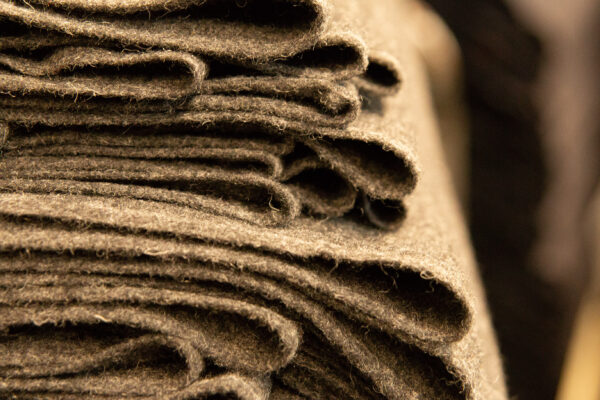Loden lexicon
Loden made from sheep’s wool
The term loden is nowadays a collective term for dense, heavier carded yarn fabrics with a melange look, which are predominantly made of sheep’s wool.
They are always densely milled and have different surface qualities.

FAQ
The term loden is nowadays a collective term for dense carded yarn fabrics with a melange and plain look, which are predominantly made of sheep’s wool.
They are always densely milled and differ in terms of surface quality.
Due to the simpler use of the term, very similar fabrics are also grouped together under the term loden, as the following properties must actually be fulfilled for a loden to exist:
- Only virgin wool is used
- Use of carded yarn
- woven in cloth weave
- milled and thus matted on the surface
- Melange look
The term loden probably comes from the Old High German word “lodo”, which means “coarse woolen cloth” or “coarse fabric”.
Although the term “lodo” has been used since the 10th cent.
the exact origin of the word “Loden” is still unclear.
The classic colors of loden are olive green, red-brown, grey-brown and mottled black.
It was originally used to make coats and blankets and was traditionally the hard-wearing clothing fabric used by Europe’s rural population.
Especially in the Alpine region and in Lapland, loden cloth is still of great traditional importance.
Today, however, loden is also produced in a wide variety of qualities and colors, as its areas of use have multiplied: Loden is now also used in the fashion segment, in the home and for club outfits.
These different uses are possible because the special processing of loden gives it a number of characteristic, positive properties.
… water-repellent The elaborate processing of the new wool, the fulling, not only makes the loden more resistant and warmer, but also extremely water-repellent. … temperature-regulating Due to the fabric structure of loden, a regular and controlled heat balance takes place, creating a microclimate zone on the body.
Loden does not let the cold through, retains body heat and thus guarantees exceptional comfort. … Breathable Virgin wool is extremely breathable, i.e. it absorbs water vapor from the body and releases it to the surface of the fabric.
This property of loden is particularly important for outerwear used for sports, such as skiing or hiking. … windproof Loden retains its wind-breaking properties because it is processed without chemical additives.
Loden retains its windproof properties up to wind force 10. … dirt-resistant Due to the fabric structure and the wool lanolin, new wool is absolutely dirt-resistant.
This means that dirt and grime can be easily brushed off the loden when dry.
The basic properties of the loden can be extended as required.
A wide variety of finishes are possible. Finishing options – water-repellent finish – oil-repellent finish – flame-retardant finish – mothproof finish – non-slip finish – antistatic finish – washable finish
Loden is traditionally made from virgin sheep’s wool, which today comes mainly from countries such as Australia/New Zealand, South Africa and South America, as the wool from these countries is softer due to special sheep breeds and the prevailing climate.
However, as a result of this change, indigenous sheep species, such as the Rhön sheep, are threatened with extinction, as their wool is no longer highly valued.
Despite intensive efforts by the chemical industry, it has not yet been possible to produce the “miracle fiber” sheep’s wool artificially.
Loden is mainly divided into eight different types, depending on the intended use and production method.
Mountain loden
It has a rustic fabric character and is made from coarser wool from the Alpine region.
It is often used to make coats and sturdy jackets.
Stroke loden (also known as sheathed loden)
Densely milled loden.
Characteristic are the fibers laid parallel in one direction.
The wool fibers are laid on top of each other like roof tiles, creating a special, water-repellent structure.
In addition, knitted loden is usually impregnated to be water-repellent and is therefore also suitable as rain protection.
Tricot loden
Woven in tricot weave.
Rarely produced today.
Velour loden
Loden with a roughened look, whereby the fibers are not laid in one direction.
This type of loden has a soft and voluminous surface.
Welsh loden
This type of loden is also called diagonal loden because the warp has a different color than the weft, making the twill weave very visible.
Walk
A knitted fuller’s loden that is not woven.
Knitted loden is cheaper than woven loden and adapts better to the curves of the body thanks to its flexible stitch structure.
It has a more uneven surface appearance and is less strong than fulling loden.
Cloth loden
(Melton loden, suit or jacket loden, Bolzano loden, cloth loden)
A heavily felted loden, woven in plain or twill weave.
It is not napped and therefore has a smooth surface.
This loden is used for the production of pants, skirts, suits, coats and costumes.
Washed loden
Modern loden version with a milled surface that is not roughened or pressed.
It has a stable, soft surface.
Walkloden
The unicorn among the loden types – it doesn’t exist.
The “Walkloden” was created by mixing the terms “Walk” and “Loden”.
Although both are made of wool, a walk is knitted, whereas a loden is woven.
This also results in different properties and applications.
At Tuchfabrik Mehler, we only offer loden.
Folgen Sie uns!
Für die neuesten Impressionen und Neuigkeiten können Sie uns auf den sozialen Medien folgen! Nutzen Sie die Links unterhalb, um zu Ihrem gewünschten Netzwerk zu gelangen.